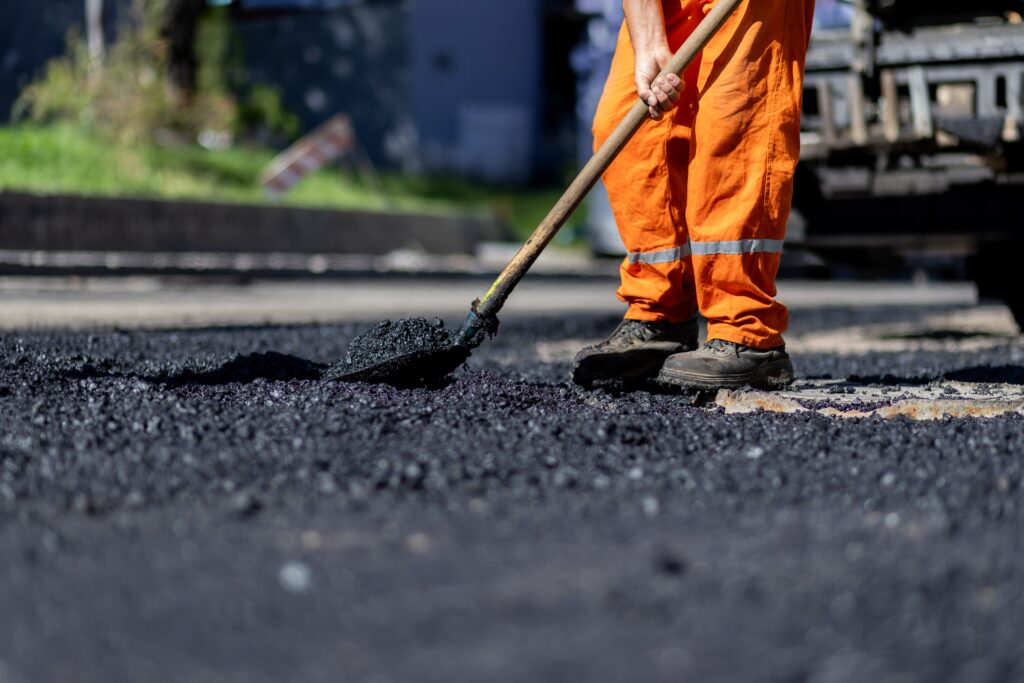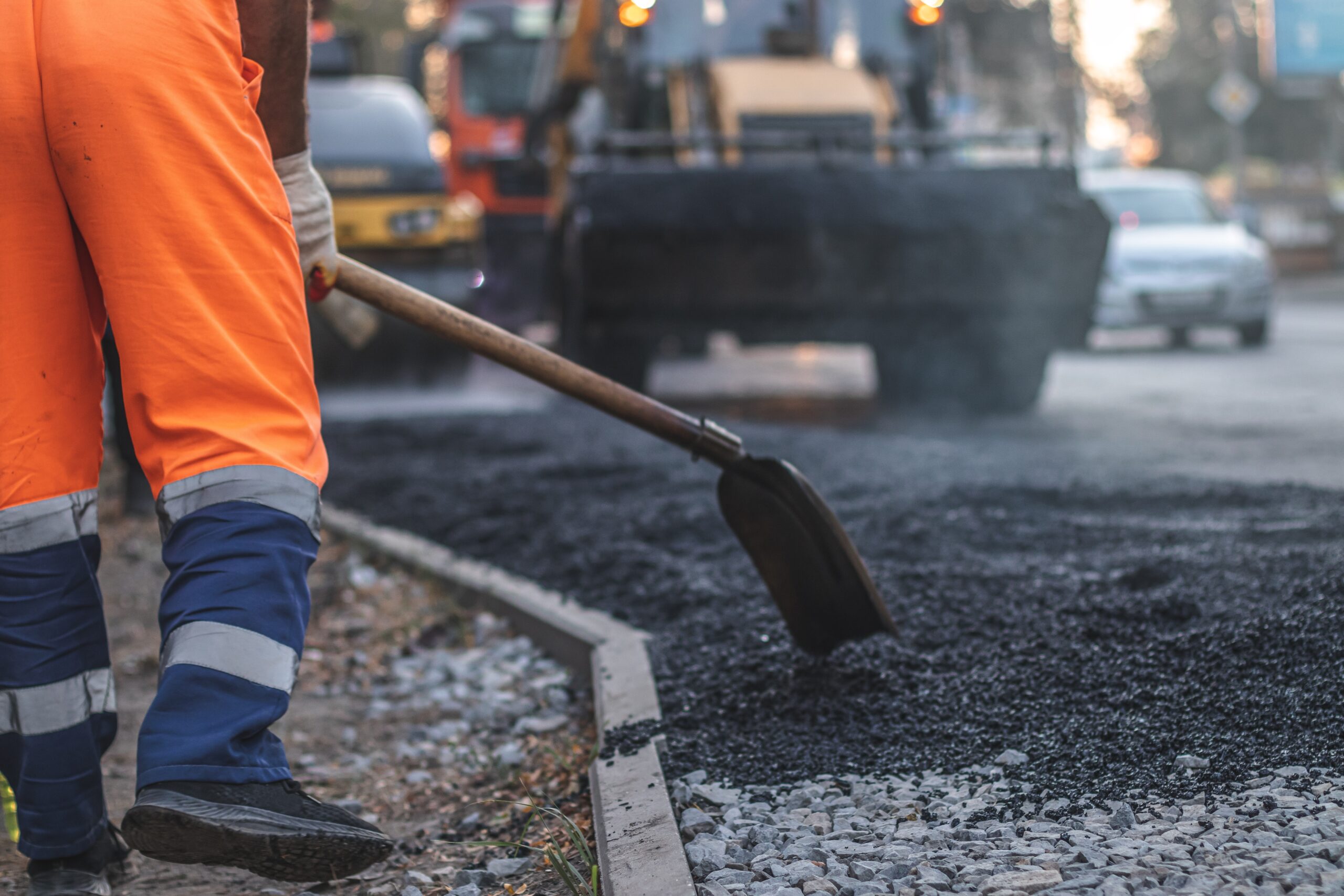
If you’re looking into asphalt paving services in Colorado Springs, you’re aiming for more than a clean layer of blacktop. You need a pavement system that can withstand constant traffic, endure Colorado’s unpredictable weather, and remain dependable year after year.
Successful asphalt paving comes down to using the right materials, ensuring solid site preparation, and working with a contractor who understands the local climate’s challenges.
According to the National Weather Service, Colorado Springs typically experiences a long freeze–thaw season, stretching from early October to early May, for which pavement must be built to withstand. When those elements are in place, your pavement lasts longer, looks sharper, and saves you money on repairs.”
Why Asphalt Paving Matters in Colorado Springs
When you own or manage property in Colorado Springs, your pavement takes on more than just traffic. It becomes part of the first impression people get when they drive onto your site, and it plays a significant role in safety and function every single day. Quality asphalt paving is what helps you avoid unexpected repairs, extend the life of your surface, and keep your property looking sharp.
The Challenges of Colorado Weather
Due to the unique climate of Colorado, asphalt in this region faces conditions that are less common in many other cities. Intense sun exposure, long stretches of freezing nights, and sudden thaws create stress that breaks down weak or poorly compacted pavement. Water is the biggest culprit—once it slips into cracks and freezes, it forces asphalt apart.
A Federal Highway Administration (FHWA) reference notes that water expands by about 9% upon freezing, which helps explain why saturated pavements crack in freeze–thaw conditions.
In addition, UV radiation intensifies at higher elevations—studies show UV exposure increases about 4% for every 1,000 feet (≈ 305 m) of elevation gain—so surfaces in high-altitude cities like Colorado Springs endure more sun-related aging.
Traffic Loads and Daily Wear
If your property experiences steady car traffic, delivery trucks, or occasional heavy equipment, your asphalt must be designed to withstand that weight. Thinner layers or shortcuts in base preparation can’t hold up under repeated pressure, and once the subbase shifts, the surface quickly follows. On the other hand, when the right depth and mix are used, asphalt distributes loads evenly, keeping your surface smoother and firmer for years to come.
The Cost of Cutting Corners
Still, many property owners learn the hard way that going with the lowest price often means paying twice. Skipping compaction steps or using a thin lift of asphalt might look fine at first, but it doesn’t last. Cracks, potholes, and drainage problems appear more frequently, and patchwork repairs become a recurring expense. By investing in a properly engineered pavement system from the start, you avoid those headaches, lower long-term costs, and protect both vehicles and pedestrians who use your property.
Transportation agencies adopt pavement-preservation strategies for the same reason: timely treatments reduce life-cycle costs and extend service life.
What Asphalt Paving Services Actually Cover
Asphalt paving involves more than laying down blacktop. Each step has a purpose, shaping how well your pavement holds up and its appearance over time. Here are the core services to expect:
- New Installation and Resurfacing: A complete installation begins at the soil level and builds a brand-new pavement system. Resurfacing adds a fresh overlay on a solid base, offering many more years of service without the cost of total reconstruction.
- Milling and Removal: Milling grinds away worn layers, allowing new asphalt to bond securely with the base. If the base is too weak, complete removal and rebuilding provide the only reliable solution. Milling also supports recycling—FHWA highlights the engineering, economic, and environmental benefits of reusing reclaimed asphalt pavement (RAP).
- Base Preparation and Compaction: Strong pavement depends on a stable base. Grading, stabilizing, and compacting the subbase ensures the asphalt above can handle heavy traffic without shifting or settling.
- Repairs and Patching: Cracks and potholes are best fixed early. Timely patching and sealing stop minor damage from spreading and protect both the structure and those who use the surface. Studies and FHWA tech briefs show that crack sealing can measurably extend pavement life when applied to sound pavements.
- Sealcoating and Striping: Sealcoating shields asphalt from moisture, oils, and sun damage. Fresh striping then improves safety, directs traffic, and upgrades curb appeal.
- Drainage and Grading Considerations: Proper grading directs water away from the pavement and its base. In areas with freeze-thaw cycles or sudden storms, good drainage design is essential to prevent early failures.
Do I need resurfacing or a complete asphalt replacement?
The best way to determine this is by examining the base. If your lot exhibits widespread cracks, potholes, or drainage issues, the foundation is likely compromised, and replacement is a smarter long-term investment. If the base is intact but the surface is worn or oxidized, resurfacing can provide many more years of reliable use.
Key Factors That Determine Cost in Colorado Springs
When preparing for an asphalt paving project, one of the most significant considerations is cost. Property owners often want a quick estimate, but in reality, no two projects are the same. Everything from soil stability to site layout can influence the final price. By understanding what contractors consider when building a quote, you’ll be in a better position to budget realistically and identify the difference between a thorough estimate and one that cuts corners.
Size and Area of the Project
The size of the job site is usually the first factor that shapes cost. A sprawling commercial parking lot demands more material, more equipment time, and larger crews, while a smaller lot or roadway section may require less of everything. Interestingly, bigger projects can sometimes lower the per-square-foot cost because crews can work more efficiently once the equipment is in place. That balance is why you’ll often see more competitive rates for larger-scale paving compared to patchwork or small sections.
For property managers and owners, this means thinking about long-term needs resurfacing paving. Resurfacing or paving a larger area at once can sometimes be more cost-effective than tackling small sections year after year. A contractor with experience in large-scale projects will help you weigh the benefits of tackling everything at once versus phasing work out.
Depth, Base Work, and Soil Conditions
The strength of asphalt begins beneath the surface. If the soil under your lot is soft, unstable, or prone to holding water, it takes extra preparation to stabilize it. That preparation might include additional compaction, the addition of aggregate base layers, or improvements to drainage systems. These steps can increase upfront costs, but they prevent premature failure that would end up costing more later.
The City of Colorado Springs’ Pavement Design Criteria Manual makes this clear, emphasizing that pavement performance depends heavily on proper subgrade evaluation, drainage planning, and pavement structure tailored to both traffic loads and local soil conditions.
Depth also matters. Thicker asphalt layers are more durable and handle heavier traffic loads, but they naturally use more material and labor. A professional contractor will recommend the proper depth based on how your lot or roadway will be used, ensuring you don’t overspend but still get the performance you need.
Asphalt Mix and Material Quality
Not every asphalt mix performs the same. Contractors in Colorado Springs often recommend specialized blends designed to handle freeze-thaw cycles, heavy UV exposure, and fluctuating temperatures. Mixes with higher binder content or performance additives resist cracking and raveling better, giving you more years of service.
While higher-quality mixes require a higher initial investment, they typically save money in the long run. Pavement engineered for local conditions reduces the need for frequent patching and early resurfacing. When reviewing estimates, it’s worth asking what mix will be used and why, as that detail can significantly impact durability.
Site Logistics and Accessibility
Some sites are straightforward, with open access and plenty of space for equipment to maneuver. Others may involve tight corners, ongoing business operations, or limited hours when work can be performed. Each of these logistical challenges can extend the timeline and increase labor requirements, which in turn affect the cost.
For example, a retail center that requires overnight paving to avoid disrupting customers will require a contractor to schedule crews differently and possibly bring in more lighting or specialized equipment. These details may not be evident to property owners, but they play a significant role in shaping project pricing.
Local Regulations and Permits
In Colorado Springs, asphalt projects must often comply with city codes and meet accessibility standards. Depending on the scope, permits may be required to ensure that drainage, slope, and traffic control measures comply with code. While permitting costs themselves are usually modest, failing to plan for compliance can create delays that ultimately cost more than the permit itself.
An experienced contractor will factor these requirements into their estimate and handle the paperwork, giving you peace of mind that the job won’t run into unnecessary obstacles. This proactive approach helps projects move smoothly and stay on schedule.
Timing and Seasonal Considerations
Because asphalt requires specific temperatures to compact and cure properly, the time of year directly affects both the cost and scheduling. Paving in the heat of summer allows for optimal results, whereas projects pushed into colder months may require additional measures, such as specialized additives or extended curing times. These adjustments add to the cost but are necessary to ensure long-term performance.
Planning ahead is often the most effective way to manage costs. By scheduling paving during peak season, you give contractors the flexibility to do the job under ideal conditions, which reduces the likelihood of problems later. Property owners who wait until late fall or early winter often face higher bids or longer turnaround times simply because of weather-related risks.
Is asphalt paving in Colorado Springs more expensive than in other regions?
It often is, but for good reason. The climate and soil conditions here mean contractors must build stronger bases, use thicker lifts, and apply mixes designed to withstand more stress than in milder areas. While the upfront price may be slightly higher, the payoff is a surface that lasts longer and requires fewer repairs, ultimately making it more cost-effective.
How to Choose a Reliable Asphalt Contractor in Colorado Springs
Selecting the right contractor is one of the most important decisions you’ll make for your paving project. Asphalt work is an investment, and the quality of the contractor’s methods, materials, and service can determine whether your surface lasts decades or needs costly repairs within a few years. By knowing what to look for, you protect your budget and ensure you’re working with a partner who delivers results you can trust.
Experience with Local Projects and Climate
When you hire a contractor who has worked extensively in Colorado Springs, you gain the benefit of local knowledge. They understand how freeze-thaw cycles, high-altitude sunlight, and sudden weather shifts impact asphalt, and they’ll choose mixes and methods that hold up under those conditions. Local experience also means familiarity with soil types, drainage challenges, and city regulations that an outside contractor might overlook.
It’s worth asking for examples of completed projects in the area. A contractor who can point to commercial lots, roadways, or municipal work nearby demonstrates that they’ve already proven their ability to handle Colorado Springs conditions. That track record gives you confidence in the durability of your own project.
Portfolio, References, and Past Work
A reliable contractor should have no problem showing you a portfolio of completed jobs. Photos, case studies, and references from past clients tell you more than a brochure ever could. When you see work that resembles your project, it becomes easier to visualize the quality you can expect.
Talking with past clients can also reveal how the contractor manages scheduling, communication, and follow-up. Smooth execution and good customer service are just as important as technical skill, especially when your business or property operations depend on timely completion.
Licensing, Bonding, Insurance, and Warranties
Proper licensing and bonding are non-negotiable. They demonstrate that the contractor meets industry and state requirements, and they protect you from liability if something goes wrong. Insurance is equally essential, covering both workers and your property during the project.
Warranties are another sign of reliability. Contractors who stand behind their work will offer clear warranty terms on both materials and workmanship. If a company avoids that discussion, it may be a red flag. Professional crews know that when work is done correctly, the pavement should perform for years without significant issues.
Transparency in Estimates and Avoiding Hidden Fees

An estimate should be more than just a lump sum. Look for contractors who break down costs for labor, materials, and additional services. Transparent pricing makes it easier to compare bids and prevents unpleasant surprises after work begins.
If a contractor provides you with a vague or unusually low estimate, exercise caution. It often means they’re leaving out critical steps, such as proper base preparation or drainage work, which will ultimately cost you more. A detailed and transparent bid demonstrates that the company has thoroughly considered every step of your project.
Communication, Scheduling, and Minimizing Disruption
Paving projects can be disruptive, but a good contractor works to minimize the impact on your daily operations. Clear communication, both before, during, and after the project, ensures that everyone is aware of the schedule and what to expect. Whether it’s coordinating with tenants, setting up traffic control, or working in phases, contractors who prioritize communication make the process smoother.
In Colorado Springs, where the weather can change plans quickly, flexible scheduling is also a valuable trait. Contractors who keep you updated and adjust efficiently are far easier to work with than those who leave you guessing.
What’s the most enormous red flag when hiring an asphalt contractor?
The biggest warning sign is a contractor who pressures you to make a quick decision or only offers vague estimates. Reputable companies welcome your questions, provide detailed proposals, and encourage you to verify references before proceeding.
The Asphalt Paving Process: What to Expect Step by Step
Knowing how the paving process unfolds gives you peace of mind and helps you set the right expectations for timing, disruption, and results. Professional contractors follow a proven sequence that ensures each layer supports the next. When you understand these steps, you can see why cutting corners almost always leads to early failures.
Site Inspection and Initial Estimate
Every paving job begins with a thorough inspection. The contractor assesses the existing pavement condition, verifies the subgrade and drainage readiness, and reviews the site dimensions. This step is critical because these observations directly inform the paving plan and cost estimate.
According to the FHWA’s Hot-Mix Asphalt Paving guidelines, a pre-paving meeting is required approximately one week before construction to review surface preparation, paving sequence, compaction methods, equipment, and other critical parameters.
The initial estimate should provide a clear picture of what the project entails. A contractor who takes time to explain their findings, outline the scope of work, and answer questions is already showing the type of transparency that builds trust.
Preparatory Work: Clearing, Grading, and Base Setup
Once the contract is in place, the site is cleared of debris, vegetation, or old pavement that won’t support the new structure. Grading is performed to create the proper slope for adequate drainage. Without proper grading, even the best asphalt won’t perform well, as standing water undermines the surface over time.
Base setup is equally important. Crews add and compact aggregate layers to stabilize the soil. This base provides the strength that asphalt needs to carry traffic loads without shifting or settling. A strong base is the foundation of every successful paving project.
Milling or Removal of Old Surface
If resurfacing is the goal, milling may be used to grind away the top layer of asphalt while preserving the base. This creates a textured surface that bonds securely with the new overlay. Milling is also environmentally friendly since the removed material can be recycled.
In cases where the old pavement has failed, complete removal is required. Crews remove everything, down to the soil, and rebuild the structure from the ground up. While this option costs more, it’s the only way to guarantee long-term performance when the foundation is compromised.
Laying and Compacting New Asphalt
Once the base is prepared, hot asphalt mix is delivered and spread evenly across the site. Specialized paving machines ensure a consistent thickness and smooth finish. Crews then use rollers to compact the asphalt, eliminating air pockets and locking the material into place.
Proper compaction is essential because it determines how well the asphalt resists traffic loads and weather stress. If the mix is not compacted correctly, it weakens quickly and leads to early cracking or ruts. FHWA guidance underscores that the contractor is responsible for achieving compaction within the specified density ranges
Final Testing, Surface Finish, and Striping
After the asphalt cools and sets, contractors inspect the surface for smoothness, proper slope, and overall quality. This stage ensures the pavement meets both engineering standards and practical use requirements. Any adjustments, such as additional rolling or fine grading, happen here.
Once the surface is approved, striping and pavement markings are applied. Clear, visible striping not only enhances the appearance of your property but also improves safety by guiding vehicles and pedestrians.
Quality Checks, Cleanup, and Punch List
Before handing the project over, contractors perform a punch list review. They confirm that every detail is complete, edges are finished cleanly, and the site is free of debris. Good contractors also walk you through the finished work, answer any questions, and provide guidance for early care.
This final step is more than a formality. It’s your assurance that the contractor has delivered a finished product that meets professional standards and your expectations.
Post-Installation Care Window
Freshly laid asphalt requires time to fully harden. During the first few days, it’s essential to limit heavy traffic, sharp turns, and parked vehicles in concentrated areas. Contractors typically provide clear instructions for this curing period, and following them closely helps ensure the strength and appearance of your new surface are locked in.
How long does a typical asphalt paving project take in Colorado Springs?
Most paving projects can be completed in a few days, depending on the size and scope. Weather, site conditions, and preparation needs can extend the timeline; however, a reliable contractor will provide a realistic schedule upfront and keep you informed if conditions change.
Common Mistakes to Avoid & Red Flags
Even well-intentioned property owners can make decisions that shorten the lifespan of their pavement. Knowing these pitfalls ahead of time helps you avoid unnecessary costs and ensures that your asphalt performs as it should. Research and design manuals consistently emphasize that overlooking fundamentals is what most often leads to premature failure.
- Ignoring Drainage and Slope Design: Water that lingers on the surface leads to cracks and potholes. Without proper grading, even new overlays fail quickly. Drainage should always be part of the design. The Best Practices Handbook on Asphalt Pavement Maintenance identifies poor drainage as one of the top contributors to early pavement distress.
- Using Low-Quality Mixes or Skimping on Thickness: Cheap materials or thin layers may appear fine at first, but they deteriorate quickly. Investing in the right mix and depth prevents early cracking and rutting. The City of Colorado Springs’ Pavement Design Criteria Manual stresses that pavement thickness and material selection must be tailored to local soil and traffic conditions.
- Choosing the Lowest Bid Without Vetting: Low bids often overlook essential steps, such as compaction or base stabilization, which can lead to costly issues later. Transparent estimates show actual value, not hidden costs. The Asphalt Pavement Association highlights that shortcuts in compaction and base prep lead directly to premature failures.
- Skipping or Delaying Maintenance: Asphalt isn’t maintenance-free. Neglecting sealcoating or crack sealing accelerates damage, cutting pavement life in half. The Best Practices Handbook on Asphalt Pavement Maintenance explains that timely crack sealing significantly slows deterioration and extends service life.
- Accepting Poor Transitions, Edges, or Patch Joints: Rough edges and sloppy joints create weak spots where damage begins. Clean, compacted transitions are signs of quality workmanship. The Asphalt Pavement Maintenance Guide from British Columbia’s Ministry of Transportation notes that open joints allow water infiltration, which can lead to structural failure.
Can asphalt paving projects be customized for different property types in Colorado Springs?
Yes. Each property—whether it’s a retail center, church, residential community, or industrial site—has unique needs. Contractors can tailor pavement thickness, asphalt mix, drainage solutions, and maintenance plans to fit the specific use and budget of the client.
Paving the Way for Stronger, Safer Surfaces in Colorado Springs
Your pavement is more than a surface—it’s part of your property’s safety, appearance, and value. Choosing professional asphalt paving means durability, smooth traffic flow, and fewer costly repairs. With the proper planning and materials, every project delivers long-term performance.
At Asphalt Coatings Company, we’ve spent decades paving with solutions built to last. When you’re ready to upgrade your pavement, call on us—we’ll provide a free site assessment and show you firsthand how our team delivers the strength, durability, and finish your property deserves.
Frequently Asked Questions
How long does new asphalt typically last?
With proper installation and regular maintenance, asphalt in Colorado Springs can last 20 years or more. Climate and traffic levels are the two primary factors that impact lifespan.
Can paving be done in colder months?
It’s possible, but colder weather limits compaction and curing. The best results are achieved by scheduling work during warmer months, when asphalt can bond and settle properly.
What is the best time of year to pave in Colorado Springs?
Late spring through early fall offers ideal conditions. Warm temperatures and lower chances of snow or freezing rain allow contractors to deliver the strongest pavement.
How disruptive will a paving project be to my business or property?
Most projects are planned to minimize interruptions. Contractors often work in phases or off-hours to keep parking lots and roads accessible whenever possible.
Do I need permits for an asphalt paving project?
Depending on the scope, you may need permits related to drainage, slope, or accessibility compliance. A professional contractor typically handles the permitting process for you.



